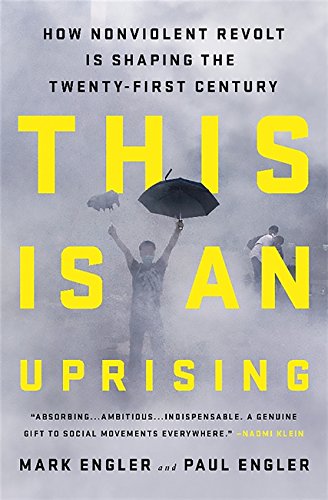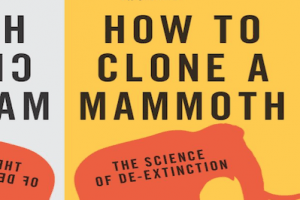This Is an Uprising
A few lessons about nonviolence "as a method of political conflict": Nonviolent movements are twice as likely to succeed as violent insurgencies; success is practically guaranteed if 3.5 percent of the population actively takes part; and effective nonviolent protest is always disruptive and polarizing.
“This Is an Uprising: How Nonviolent Revolt Is Shaping the Twenty-First Century” A book by Mark Engler and Paul Engler
In the spring of 1930, in what would become one of the 20th century’s most famous acts of civil disobedience, Mohandas Gandhi led his followers to the Arabian Sea, where they bent down and scooped up handfuls of salt. This was in open violation of British laws that prohibited Indians from collecting or selling salt, and the march, which grew from dozens to thousands as it made its way east, sparked a revolt across the country. Soon it involved millions of Indians, resulting in more than 60,000 arrests.
The Salt March, as it became known, was Gandhi at his strategic best. As one biographer noted, the choice of targets — salt — was “the weirdest and most brilliant political challenge of modern times.” Those unfamiliar with the history can probably guess the rest: The British never recover and the quest for Indian independence is victorious, proof that nonviolent action can topple a foreign power. A predictable book about social movements would slide along these well-worn grooves, leaving readers with a warm feeling but without offering new insights.
Mark Engler and Paul Engler haven’t written a predictable book. The brothers have spent considerable time studying — and participating in — social movements, and their deep curiosity lends a propulsive feel to “This Is An Uprising: How Nonviolent Revolt Is Shaping the Twenty-First Century.” The book careens around the globe, diving into campaigns and surfacing to offer fresh and often surprising lessons, even when examining well-known events. Consider the Salt March. Despite large mobilizations, negotiations with the British made little progress toward Indian independence. At the conclusion of the protests, the agreement secured by Gandhi didn’t even get rid of the Salt Act. After Indians had endured months of sacrifice — their property confiscated, their bodies whipped in public — they had come away with virtually nothing to show for it. Jawaharlal Nehru, who would become the country’s first prime minister, wrote that the experience left him with “a great emptiness as of something precious gone, almost beyond recall.”
It took some time to recognize that the ground had shifted — and wouldn’t shift back. The British had been forced to negotiate; Indians had learned they could revolt. The lack of having achieved what the Englers call an “instrumental value” — an immediate and concrete change in policy — had to be seen in this context. “That the Salt March might at once be considered a pivotal advance for the cause of Indian independence and a botched campaign that produced few tangible results seems to be a puzzling contradiction,” they write.
In fact, as their book shows, this sort of “contradiction” is far from uncommon. One of the civil rights movement’s most storied campaigns was the effort to desegregate Birmingham, Ala., where protesters — children included — were viciously set upon by police dogs. That campaign ended in a highly ambiguous agreement with local officials: Some public facilities were desegregated; others were not. One sympathetic white argued that “King had won little or nothing.” Fred Shuttleworth, a close associate of King’s, made little attempt to disguise his disgust with the limited terms of the accord. That events in Birmingham would later be considered the decisive factor in causing President Lyndon Johnson to sign the Civil Rights Act of 1964 underscores just how confusing such moments can be. The world is already messy and chaotic; social movements make it more so. And so a book like “This Is an Uprising” — crisply written, rigorous, blessedly free of cliches — is long overdue.
“Nonviolence is usually regarded as a philosophy or moral code,” the Englers write in the book’s introduction. “Much less frequently is it studied as a method of political conflict, disruption, and escalation.” In recent years, however, a small band of scholars has begun to study the topic in earnest, organized within a field called “civil resistance.” I had never heard of the term before, and the book serves as a sort of survey course, offering up some of the field’s major findings. For those inclined toward nonviolence, many are encouraging.
One of the leading scholars of civil resistance is Erica Chenoweth, a political science professor at the University of Denver. Chenoweth and a colleague, Maria Stephan, created an extensive database of social movements worldwide. They discovered that nonviolent movements were twice as likely to succeed as violent insurgencies. Digging deeper, Chenoweth also uncovered what she called the “3.5 percent rule”: a campaign was practically guaranteed to succeed if 3.5 percent of the population actively took part. Many campaigns won with much less support.
Another lesson: Nonviolent protest, if it is to succeed, is always disruptive and polarizing. The Englers cite ACT UP and the young undocumented immigrant DREAMers as examples of militant groups who, through both extreme sacrifice and disruption, forced change when the odds against their campaigns were long. They quote journalist David Roberts’ maxim, “If you want to move the center, you have to pull on one end.” The idea that friction-free progress is possible may be the primary explanation why so many critics who profess to agree with a movement’s aims so quickly condemn their “divisive” approach. They want change in a way that change never comes: easily and without conflict. The authors remind us that King’s “Letter From a Birmingham City Jail” was not written in reaction to racist opponents, but to “would-be supporters who criticized the movement’s approach as too pushy and impetuous.”
Acknowledging that social change work is polarizing doesn’t mean that organizers are free to do whatever feels good without regard to the consequences. The point, after all, is to force people to take sides and eventually shift public opinion to your side. In Oakland, the Occupy movement was initially strong and relatively unified, but after marches continued to end with windows being broken by Black Bloc folks, the crowds shriveled up. Whether breaking the windows of a multinational bank constituted “violence” was immaterial; the point was that members of the public perceived it as violence, or at least something to stay away from.One of the most compelling sections of the book deals with the conflict between what the authors call “structure” and “movement” perspectives of social change. The structure lineage is traced back to community organizers like Saul Alinsky, who focused on building stable, membership-based groups that were usually confined to a single neighborhood or city. These groups worked on specific, clearly winnable goals. As Alinsky’s successor at the Industrial Areas Foundation, Ed Chambers, wrote, “We don’t lead everyday, ordinary people into public failures, and we’re not building movements. … Everyday people need incremental success over months and sometimes years.” Of course, as Chambers seems to have forgotten, “everyday, ordinary people” also make movements.
The movement perspective tends to focus on the rare moments when uprisings burst into the open, and argues that during such periods, existing social justice organizations tend to dampen, instead of escalate, the protest. As Frances Fox Piven and Richard Cloward, two key proponents of this idea, memorably wrote, “All too often, when workers erupted into strikes, organizers collected dues cards; when tenants refused to pay rent and stood off marshals, organizers formed building committees; when people were burning and looting, organizers used this ‘moment of madness’ to draft constitutions.”
In truth, the two strategies are much more synergistic than is usually appreciated. The civil rights movement became a mass movement, but it was preceded by unsung heroes who did the day-to-day organizing work long before any “movement” had sprouted. African-American women in Montgomery, Ala., for example, had been organizing for years before they called the boycott, and the networks they created in the process were crucial to the boycott’s success.
But there are no doubt tensions between the two perspectives. As the Englers write: “The transactional gains of structure-based organizing produce genuine benefits in people’s lives. … And yet, because they are generally suspicious of the sudden energy created by trigger events, organizers in this tradition miss opportunities to tap the vast potential of whirlwinds.”
One of the significant developments of recent years is the extent to which established social justice groups — especially labor unions — have learned to embrace what the Englers call whirlwinds, which are by definition disruptive and less easy to control, instead of dismissing or belittling them. A clear example was labor’s mobilization to support Occupy, which granted a degree of respectability to what hostile observers had originally characterized as a bunch of spoiled and scruffy white kids. And taking risks can be contagious. The spirit of Occupy — rowdy, audacious, hopeful — no doubt influenced labor’s current flagship campaign, the Fight for $15, which looks more like a movement than anything unions have attempted in a long time.
“There is no tactical theory so neat that a revolutionary struggle for a share of power can be won merely by pressing a row of buttons,” King once wrote. Wisely, “This Is an Uprising” avoids laying down any immutable “rules” that activists must follow. What the book provides, instead, is a set of theoretical frameworks for thinking about the strategies and tactics used by nonviolent movements, grounded in a diverse collection of real world examples, from the ouster of Slobodan Milosevic in Serbia to the successful living-wage campaign at Harvard University. For anyone interested in the dynamics of nonviolent social change, either as a participant or student, “This Is an Uprising” shouldn’t be missed.
Your support matters…Independent journalism is under threat and overshadowed by heavily funded mainstream media.
You can help level the playing field. Become a member.
Your tax-deductible contribution keeps us digging beneath the headlines to give you thought-provoking, investigative reporting and analysis that unearths what's really happening- without compromise.
Give today to support our courageous, independent journalists.







You need to be a supporter to comment.
There are currently no responses to this article.
Be the first to respond.